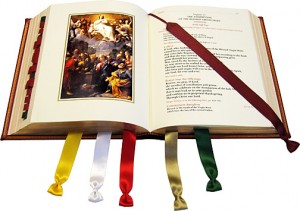The New Roman Missal: Focus on Christology
 From “We believe” to “I believe”
From “We believe” to “I believe”
Can a one-letter word really make a great difference? In the case of the revised translation of the Nicene Creed in the new Roman Missal, the answer is emphatically, “Yes!”
Instead of starting the Creed by saying, “We believe in one God…” we will begin by saying, “I believe in one God.”
Vatican II, English was the only major language that translated the opening Latin word of the Creed (“credo,” which means, “I believe”) with the plural “We believe.” The singular “I,” however, makes the Creed more personal and challenges each individual to interiorize the faith. As the Catechism explains, “I believe” expresses “the faith of the Church professed personally by each believer” (Catechism, no. 167).
This is what we do when we renew our baptismal promises during the Easter season or when attending a baptism. The priest asks if we believe in the various propositions of faith enumerated in the Creed: “Do you believe in God the Father, the Almighty?” “Do you believe in Jesus Christ his only begotten Son…?” And every individual answers for himself, saying, “I do.” It is fitting that we will now regularly make a similar personal act of faith by using the singular “I believe” whenever the Creed is recited in the Mass.
From “One in being” to “Consubstantial”
The revised translation of the Creed aims to help us more perfectly understand and declare the nature of the Son and the quality of His relationship with the Father. The previous wording referred to Jesus as “one in being with the Father.” We will now speak of Jesus being “consubstantial with the Father.”
So what is the difference? Simply put, the new wording more accurately presents the ancient and orthodox truths of Catholicism, as first established at the Council of Nicaea in AD 325. That meeting was the first of seven ecumenical councils which drew bishops from across Christendom to deliberate the finer points of theology. At Nicaea, the orthodox bishops were specifically interested in safeguard the identity of Jesus as the eternal Son of God, equal to the Father, begotten and not made. The council condemned the false teaching of an Alexandrian presbyter named Arius, who wrongly preached that the Son was a creature, and therefore inferior to the Father. He said the Son of God “came to be from things that were not” and the Son was “from another substance” than the Father (Catechism, no. 465).
In opposition to this, the Council of Nicaea taught that the Son is “God from God, light from light, true God from true God” and “of the same substance” (homoousios in Greek) as the Father. The Son was not created by the Father, but rather is a distinct divine Person who has existed from all eternity, sharing the same divine nature with the Father and the Holy Spirit. This dogma was discerned by careful study of Scripture, especially the works of John and the wisdom literature of the Old Testament.
When homoousios was translated from Greek into Latin, it was rendered consubstantialem, which has traditionally been translated as “consubstantial.” The new translation of the Mass reclaims this precise rendering and invites us to reflect on the divine nature of Christ and the mystery of the Trinity.
From “Was Born” to “Was Incarnate”
Another important theological term reintroduced to the Creed concerns the manifestation of God the Son in time as Jesus the Man. The older translation referred to the Son in this way: “By the power of the Holy Spirit he was born of the Virgin Mary, and became man.” The new translation proclaims that Jesus “by the Holy Spirit was incarnate of the Virgin Mary, and became man.”
This phraseology accurately reflects the Latin text of the Mass which includes the word incarnatus (“incarnate”).This theological term refers to “the fact that the Son of God assumed a human nature in order to accomplish our salvation in it” (Catechism, no. 461). In the words of John’s gospel, “The Word became flesh” (John 1:14). Accordingly, we now say that the Son, “by the Holy Spirit was incarnate of the Virgin Mary, and became man.” This technical term better captures the carefully expressed language of the Creed. The Son of God was not just born of the Virgin Mary. The Eternal Son of God actually took on human flesh!

